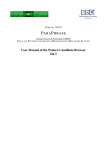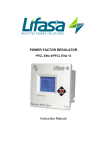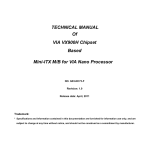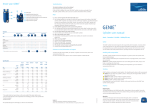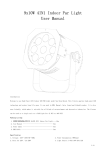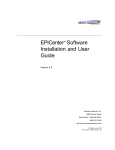Download Vector jump protection function block description
Transcript
Vector jump protection function block description Document ID: VERSION 1.0 Budapest, March 2012. IED-EP+ Vector jump protection User’s manual version information Version Version 1.0 VERSION 1.0 Date 07.03.2012. Modification First edition Compiled by Petri 2/10 IED-EP+ Vector jump protection CONTENTS 1 Vector jump protection function ...........................................................................................4 1.1 Application ....................................................................................................................4 1.2 Mode of operation ........................................................................................................4 1.3 Structure of the vector jump protection algorithm ........................................................5 1.3.1 The Fourier calculation .............................................................................................7 1.3.2 The symmetrical component calculation ..................................................................7 1.3.3 The frequency calculation.........................................................................................7 1.3.4 The vector jump calculation ......................................................................................8 1.3.5 The decision logic .....................................................................................................8 1.4 Technical summary ......................................................................................................9 1.4.1 Technical data .......................................................................................................9 1.4.2 The parameters .....................................................................................................9 1.4.3 Binary output status signal ................................................................................. 10 1.4.4 Binary input status signals ................................................................................. 10 1.4.5 The function block .............................................................................................. 10 VERSION 1.0 3/10 IED-EP+ Vector jump protection 1 Vector jump protection function 1.1 Application The modern electric power systems include an increasing number of small generators (distributed generation system). There can be several events in the network resulting that the small generators get disconnected from the system, and the small generator supplies some consumer only, remaining in the electric “island” (unintended islanding). If a small generator remains in an island with some consumers, it is highly possible that the balance of the generated and consumed active and reactive power is not fulfilled. This results changing of the frequency and/or voltage, accordingly the voltage vector position of the island is changing, related to that of the disconnected grid. An automatic reclosing of the circuit breaker at an unfavorable vector position can result high currents and serious damages. To prevent these damages a protection is needed to detect the islanding and to disconnect the generator from the island. One of the protection methods to detect unintended islanding is this vector jump protection function. 1.2 Mode of operation When an unintended islanding occurs then the induced voltage inside the generator (EMF) may not change abruptly. As a consequence, on other locations within the island (at the connection point of the generator, at the bus-bar or at the consumer) a sudden change of the voltage vector can be detected. It means that the vector „jumps”, the time period of the sinusoid at the moment of the change can be shorter or longer than the previous or subsequent ones. The main task of the vector jump protection function is to detect the unintended islanding, when the generator with some consumer area is disconnected from the electric power grid. The application of the vector jump function needs careful setting. One of the problems is caused by the scenario, when the balance of the electric power before and after the islanding is not changing significantly (the generated and consumed power within the island is balanced). Accordingly the limit for jump detection must be set to a low angle value, but there is no guarantee that the islanding is detected by this method. At the same time, however, a switching of a relatively large consumer can cause also a vector jump. To prevent the unwanted trip, in this scenario the setting limit for the vector jump angle should be selected large. For vector jump detection the function must be enabled, and the measured positive sequence voltage component must be above a minimum value. If a fault occurs on the network, the voltage vector jumps. In this case a decision is needed if the role of the vector jump function is the fault protection, or the fault is to be cleared at other locations of the network. For excluding the operation in case of asymmetrical faults, the negatives sequence and zero sequence voltage components must be supervised. If they are above the setting, asymmetrical fault is detected and the operation of the vector jump protection function is blocked. For vector jump detection the function must be enabled, and the measured voltage must be above a minimum value. For disabling the operation in case of low voltage an additional undervoltage binary input is provided. VERSION 1.0 4/10 IED-EP+ Vector jump protection If the network frequency is deviating from the nominal frequency then the voltage vector rotates slowly in the complex coordinate system. As the vector jump detection function is based on comparison of the vectors of the actual and some previous states, the vector rotation caused by the frequency deviation must be compensated. For this purpose also the network frequency is measured continuously. 1.3 Structure of the vector jump protection algorithm The scheme of operation of the vector jump protection function is shown in Figure Fourier calculation nn UL UL UL Symmetrical component calculation UL1 Pos UL2 Neg UL3 Zero 1-1. Vector jump Vector jump calculation Decision logic Bin output s Frequency calculation Bin inputs Parameter Figure 1-1 Structure of the vector jump protection algorithm The inputs are • the three phase voltages, • parameters, • status signals. NOTE: in some device configurations also the residual voltage is measured separately. In this case the zero sequence voltage component is calculated directly from the residual voltage. For the actual realization please consult the configuration manual delivered with the device. The output is • the binary output status signal for tripping. The software modules of the vector jump protection function are: VERSION 1.0 5/10 IED-EP+ Vector jump protection Modules for processing the input signals: Fourier calculations These modules calculate the basic Fourier components of the phase voltages individually. (They are not part of the Vector jump function.) Positive sequence component calculation This module calculates the positive sequence voltage component based on the basic Fourier components of the phase voltages. (It is not part of the Vector jump function). The magnitude of the positive sequent voltage component must be above the setting to enable the operation. Negative sequence component calculation This module calculates the negative sequence voltage component based on the basic Fourier components of the phase voltages. (It is not part of the Vector jump function). If the magnitude of the negative sequent voltage component is above the setting then an asymmetrical fault is supposed and the operation of the vector jump protection function is blocked. Zero sequence component calculation This module calculates the zero sequence voltage component based on the basic Fourier components of the phase voltages. (It is not part of the Vector jump function). If the magnitude of the zero sequent voltage component is above the setting then an asymmetrical fault is supposed and the operation of the vector jump protection function is blocked. Frequency calculation This module calculates the frequency. (It is not part of the Vector jump function.) Based on the frequency value the calculated angle of the vector jump is corrected, if the frequency deviates from the rated frequency. Modules for vector jump detection and decision: Vector jump calculation This module calculates the vector jump, based on the Fourier components of the positive sequence voltage component. Decision logic The decision logic module combines the status signals to generate the trip command of the function. The following description explains the details of the individual components. VERSION 1.0 6/10 IED-EP+ Vector jump protection 1.3.1 The Fourier calculation These modules calculate the basic Fourier components of the phase voltages individually. They are not part of the vector jump function; they belong to the preparatory phase. The inputs are the sampled values of the three phase voltages (UL1, UL2, UL3) The outputs are the basic Fourier components of the analyzed voltages (UL1Four, UL2Four, UL3Four). NOTE: in some device configurations also the residual voltage is measured separately. In this case the zero sequence voltage component is calculated directly from the residual voltage. For the actual realization please consult the configuration manual delivered with the device. 1.3.2 The symmetrical component calculation These modules (Positive sequence component calculation, negative sequence component calculation, zero sequence component calculation) calculate the magnitudes and phase angles of the symmetrical components, based on the theory of the component calculation. The magnitude of the positive sequent component is used to enable the vector jump decision. The magnitudes of the negative and zero sequence components can disable the vector jump decision. The angle of the vector jump is calculated based on the angle of the positive sequence component and the angle of this component two periods before. The rotation of the vector caused by the frequency deviation is compensated based on the frequency input. NOTE: in some device configurations also the residual voltage is measured separately. In this case the zero sequence voltage component is calculated directly from the residual voltage. For the actual realization please consult the configuration manual delivered with the device. The inputs of this module are the basic Fourier components of the phase voltages (UL1Four, UL2Four, IUL3Four). The outputs of this module are the basic Fourier components of the positive, negative and zero sequence voltage components, given in terms of magnitudes and phase angles. 1.3.3 The frequency calculation Depending on the hardware-software configuration, the frequency measurement is usually based on channel No. 1 of the voltage input module. In some applications, the frequency is measured based on the weighted sum of the phase voltages. For the actual realization please consult the configuration manual delivered with the device. The accurate frequency measurement is performed by measuring the time period between two rising edges at zero crossing of a voltage signal. For the acceptance of the measured frequency, at least four subsequent identical measurements are needed. Similarly, four invalid measurements are needed to reset the measured frequency to zero. The basic criterion is that the evaluated voltage should be above 30% of the rated voltage value. The inputs of this module are assigned voltages channels, according to the device configuration. The output of this module is the calculated frequency in mHz units. VERSION 1.0 7/10 IED-EP+ Vector jump protection 1.3.4 The vector jump calculation The vector jump is the difference between the phase angle of the actual positive sequence component and the angle measured two network periods earlier. A vector jump is detected if the absolute value of the calculated angle difference is above the setting value. The inputs of this module are the data of the positive sequence voltage, the frequency and the setting value of the vector jump. The module stores the angles of the positive sequence voltage component in the memory for two network periods, and calculates the “raw” vector jump. This value is corrected if the frequency deviates from the rated network frequency. The binary output of this module is true if the corrected vector jump is above the setting value. 1.3.5 The decision logic The decision logic module combines the status signals and parameters to generate the trip command of the function. The performed logic is a simple one: a trip command is generated if: • The calculated vector jump is above the setting value, • The magnitude of the positive sequence voltage component is above the setting value, • The magnitude of the negative sequence voltage component is below the setting value, • The magnitude of the zero sequence voltage component is below the setting value, • The “Blk” binary input does not block the function, and • The “UVBlk” binary input does not block the function. The vector jump means that one network frequency period of the voltage sinusoid is shorter or longer than the previous periods or that of the subsequent periods. This binary information must be prolonged to generate the trip pulse. The minimum duration of the trip command is set by a parameter. NOTE: when checking the pulse duration please consider that the timer parameter defines the prolongation, the operating time span is added to the pulse duration. VERSION 1.0 8/10 IED-EP+ Vector jump protection 1.4 Technical summary 1.4.1 Technical data Function Pick-up starting accuracy Blocking voltage Operate time Jump>2*setting Minimum operate time Pulse duration Value Accuracy < ± 0,5° < 5% U>0.2Un <50 ms 40 ms 150 … 500 ms <10 ms Table 1-1 Technical data of the vector jump protection function 1.4.2 The parameters Enumerated parameters Parameter name Title Selection range Enabling or disabling the vector jump protection function VectJmp_Oper_EPar_ Operation Off,On Default Off Table 1-2 The enumerated parameters of the vector jump protection function Integer parameters Parameter name Title Unit Min Max Step Default Starting phase difference level setting. If the vector jump is above the setting value, the function generates a start signal. VectJmp_PhDiff_IPar_ PhaseDiff Limit deg 5 25 1 10 Enabling positive voltage level setting. If the measured positive sequence voltage component is above the setting value, the function enables the trip signal. VectJmp_UposLim_IPar_ Min PosSeq Voltage % 10 100 1 30 Blocking negative sequence voltage level setting. If the measured negative sequence voltage component is above the setting value, the function blocks the trip signal. VectJmp_UnegLim_IPar_ Max NegSeq Voltage % 5 50 1 10 Blocking zero sequence voltage level setting. If the measured voltage is above the setting value, the function blocks the trip signal. VectJmp_UoLim_IPar_ Max ZeroSeq Voltage % 1 30 1 5 Table 1-3 Integer parameters of the vector jump protection function Timer parameter Parameter name Title Trip command pulse duration VectJmp_Pulse_TPar_ Pulse Duration Unit Min Max Step Default msec 150 500 1 150 Table 1-4 Timer parameter of the vector jump protection function VERSION 1.0 9/10 IED-EP+ Vector jump protection 1.4.3 Binary output status signal The binary output status signal of vector jump protection function is shown in Table 1-5. Binary status signal VectJmp_Trip_GrI_ Title Trip Explanation Trip command of the function Table 1-5 The binary output status signals of the vector jump protection function 1.4.4 Binary input status signals Binary input signals The vector jump protection function has binary input signals, which serve the purpose of disabling the function. The conditions of disabling are defined by the user, applying the graphic equation editor. Binary status signal VectJmp_Blk_GrO_ Title Blk VectJmp_UVBlk_GrO_ UVBlk Explanation General blocking status signal External under-voltage blocking status signal Table 1-6 The binary input signal of vector jump protection function 1.4.5 The function block The function block of vector jump protection function is shown in Figure 1-2. This block shows all binary input and output status signals that are applicable in the graphic logic editor. Figure 1-2 The function block of vector jump protection function VERSION 1.0 10/10














